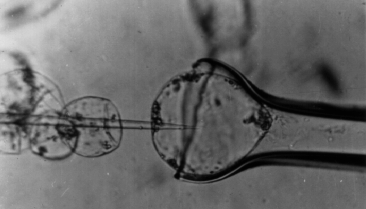 Activation
of K+ outward rectifying channels and induction of RAB18
gene expression depend on an extracellular perception of ABA in Arabidopsis
thaliana suspension cells.
Activation
of K+ outward rectifying channels and induction of RAB18
gene expression depend on an extracellular perception of ABA in Arabidopsis
thaliana suspension cells.

|
Intact cell studied in DSEVC |
Téléchargez nos publications récentes au format PDF: ABA (196Ko).
The ubiquitous plant hormone ABA (abscissic acid) is involved in the control of many physiological processes. ABA regulates different phases of growth and development and contributes to adaptive responses to environmental stresses such as drought, salinity or chilling. Upstream to the physiological ABA responses, knowledge of the transduction pathways is still incomplete in spite of recent results aimed to identify messengers of the ABA signalling cascade. The main results showed the involvement of both K+ [1] and anionic channels [2] in the regulation of stomatal movement. Moreover, the molecular genetic analysis of ABA response mutants [3] have shown that transcription factors, dephosphorylation and farnesylation seem also involved in ABA responses [4] .
Conflictual results concerning the site of ABA perception have been published. The prevalent conclusion is that since ABA controls many responses, different perception sites for ABA might exist (on external side of the plasma membrane or/and into the cell). In order to establish the cellular localisation of the ABA perception sites in Arabidopsis thaliana suspension cells, we developed two physiological tests based upon the capacity of impermeant ABA-BSA conjugate to mimic permeant free racemic (+/-)-cis-trans-ABA and the enantiomer (+)-cis-trans- ABA effects.
We show that purified ABA-BSA conjugate is able to trigger RAB18 gene expression and that this response is strictly due to the natural (+)-ABA enantiomer. The accumulation of RAB18 transcripts which are widely and specifically induced in Arabidopsis thaliana wild-type plants exposed to low temperature or desiccation and when exogenous ABA is applied to the aba1 deficient ABA mutant. The rate of RAB18 gene expression was independent on the level of ABA uptake by the cells.
Using the voltage-clamp technique [5], our results clearly indicate that the effects of ABA–BSA on the plasma membrane of Arabidopsis thaliana cells mimic the electrical response to ABA, in terms of initial depolarization and outward rectifying currents "ORC" activation [6]. We demonstrate that those ORC are due to a K+ efflux as assessed by tail currents and specific inhibition by both tetraethylammonium (TEA) and Ba2+. The effects of racemic (+/-)-cis-trans-ABA, enantiomer (+)-cis-trans- ABA and ABA-BSA occur with the same ABA concentration (10-5 M) and 1 to 10 min after their extracellular application. In response to ABA, early membrane depolarization was observed. It was suggested that this rapid depolarization was due to the activity of anion channels controlled by ABA. In such a transduction pathway, K+ ORC are activated by the depolarization and might participate in repolarizing the membrane potential. It is likely that the same sequence of events occurs in our experiments when ABA-BSA conjugate or enantiomer (+)-cis-trans- ABA was used instead of racemic ABA.
These observations provide evidence in favour of an extracellular localisation for plant hormone ABA perception [6].
[1] Giraudat, J. (1995) Curr. Opinions Cell Biol,. 7 : 232-238.
[2] Grabov A. et al., (1997) Plant J., 12 : 203-213.
[3] Leung J. and Giraudat J., (1998) Annu. Rev. Physiol. Plant Mol. Biol., 49 : 199- 222.
[4] Bonetta D. and McCourt P. (1998) Trends in Plant Science, 3 : 231-235.
[5] Bouteau F. et al., (1996) Physiol Plant., 98 : 97-104.
[6] Jeannette E. et al., (1999) Plant J., 1 : 13-22 .







